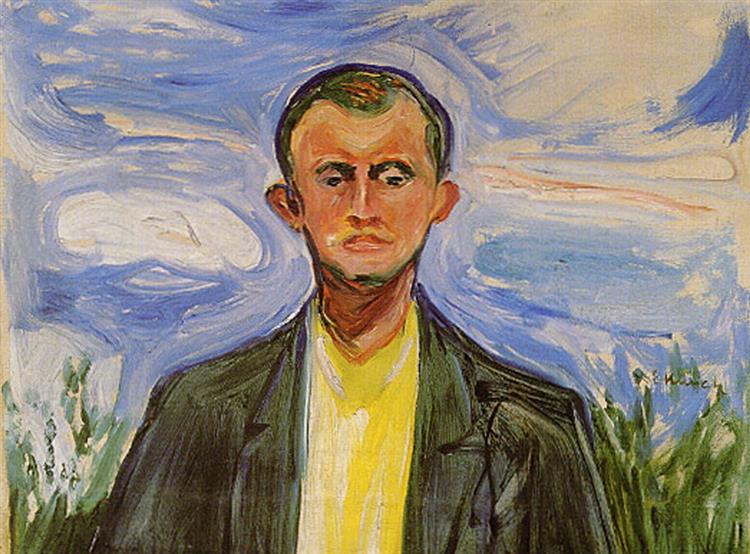Description
In the work "Self -portrait against the blue sky" of Edvard Munch, created in 1908, there is a complex but at the same time accessible interaction between the artist and his surroundings, a silent dialogue that invites the viewer to explore the depths of identity and identity and The human psyche. Munch, known for his emotional and expressionist approach, uses this painting as a means to express not only his own image, but also his relationship with the surrounding world.
The composition of the work is markedly simple but loaded with symbolism. In the foreground, Munch's face is represented in a style that mixes the clarity of representation with a remarkable expressiveness. His face, of marked features and an introspective gestures, is placed in front of an extensive blue background that represents the sky. This use of color is essential to transmit sensations of vastness and depth, contrasting with the immediacy and vulnerability that emanates from self -portrait. Blue, in its purest hue, evokes calm and reflection, while suggesting an infinite space, an environment that can be both liberating and scary.
The use of color is also worthy of attention. Munch uses a predominantly cold palette, where blue becomes the absolute protagonist, symbolizing with his clear tone a possible hope, or perhaps a longing for freedom. However, the touches of shadows on the face of Munch, as well as the lines that seem to mark their forehead, evoke a feeling of anguish and loneliness that has been recurrent in his work. It is this contrast between the ethereal and the earthly that enriches the interpretation of the work.
Throughout his career, Munch explored self -analysis and introspection, issues that are palpable in works such as "The cry" and "La Madonna". However, in "Self -portrait in front of the blue sky," Munch seems to take a step towards self -provoking, symbolizing a time when the internal struggle is at a point of break and contemplation. The artist's gaze, which radiates a mixture of melancholy and connection, invites the spectator to confront the reality of his Own existence.
It is relevant to mention that Munch was part of the expressionist movement, an artistic style that is characterized by emphasizing emotional expression over objective representation. This work, despite its appearance of simplicity, stands as a testimony of the creator's emotional tumult and offers a penetrating look at the existential anguish he experienced. Within the tradition of self -portrait, this work stands out for its uniqueness; It does not seek the idealization of the subject, but embraces its vulnerability. Thus, "self -portrait against blue sky" becomes a deeply human work, which reflects the constant struggle between light and darkness within each being.
Munch, through this self -portrait, not only shows his face, but, in some way, opens a window to his inner world, where heavens can be both broad and oppressive. The work is in perfect resonance with the theme of personal tension that characterizes many of its paintings, evoking the fragility of the human condition against the immensity of the universe. In it, Munch manages to encapsulate both his identity and an individual and his collective experience as a human being, which makes "self -portrait against blue sky" into an essential piece to understand his artistic legacy.
KUADROS ©, a famous paint on your wall.
Hand-made oil painting reproductions, with the quality of professional artists and the distinctive seal of KUADROS ©.
Art reproduction service with satisfaction guarantee. If you are not completely satisfied with the replica of your painting, we refund your money 100%.

